Catch Constellations
Catch Constellations
Hello everyone! My name is Dianne and this is my blog on everything space related! While I am currently writing more about news updates and what’s currently going on in the space world than anything else, I hope to branch out - catch other constellations, so to speak - and contribute more content such as quotes, commentaries, videos, explanations of scientific concepts, and more.
I created this blog not only because I wanted to share my love for space with anyone who happens to find this little corner of the internet, but also because I wanted to do it in a way that isn’t too techno-jargon-filled or confusing. As a STEM major, I know how confusing trying to understand complicated scientific concepts can be, and that’s why I’ll do my best to make sure everyone and anyone can enjoy my posts!

A little bit about me:
- I’m currently a sophomore at the University of Central Florida, studying biotechnology and planning to enter the astrobiology/sustainable energy fields one day.
- I love space, which may seem obvious given this blog, but it is sincerely one of my life goals to become an astronaut and go beyond Earth. It has been ever since I was a little girl. There is so much out there that we don’t know, that we can explore, that we can learn from!
- When I’m not studying or planning to take over NASA, you can find me writing and journaling, buried in a book, singing my lungs out to Disney songs or Broadway soundtracks, or generally doing a bunch of nerdy stuff.
- Rapid fire personality points! INFJ + Hufflepuff + Virgo
Alright! This will be it for my first blog post. I’ll be back soon with updates on some really cool space news. Until then, ad astra!

More Posts from Catchconstellations-blog and Others
First Discovery of Atmosphere on Known Exoplanet
While news of Trappist-1′s potentially inhospitable environment made its way through the news feeds, a new discovery emerged to make up for it: an existing atmosphere on exoplanet GJ1132b.
Located 39 light years away (just around the corner in galactic terms), the exoplanet is similar to Earth in size and mass, and is in close-orbit to its star: a dim red dwarf just slightly cooler and smaller than our own Sun. It was discovered in 2015, but it’s only now that scientists have been able to take a closer look at its composition.
While the distance between GJ and its host star is more similar to the one between Venus and our Sun, therefore most likely rendering the exoplanet incapable of hosting life due to extreme surface temperatures of up to 370 degrees Celsius/700 degrees Fahrenheit, the most important aspect to focus on is the discovery is the atmosphere that exists on GJ.
Using advanced technology that picks out biochemical signatures such as those of oxygen, methane, and hydrogen, scientists have identified a thick atmosphere of either steam or methane surrounding GJ. While this is not a certain indicator of life, it is an crucial step in increasing our knowledge of potentially habitable alien planets out there.
It is definitely interesting to see that scientists have found the first alien atmosphere that isn’t Earth’s. It seems that many of the Earth-like planets scientists have discovered are inclined to orbit red dwarf stars like Earth and that of GJ1132b. I wonder if we specifically target finding red dwarves, will wel increase our chances of finding more and more Earth-like exoplanets that could be capable of having life? It’s something to think about as we continue moving into the future.
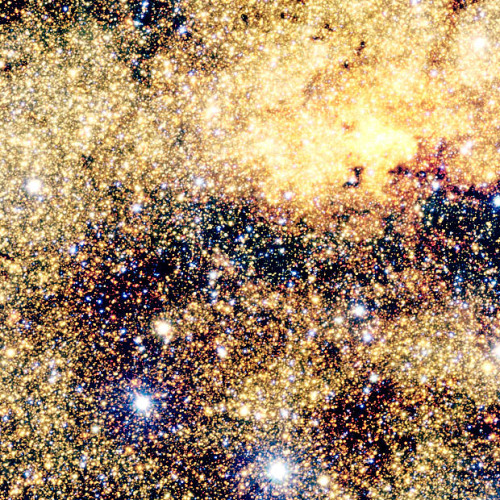
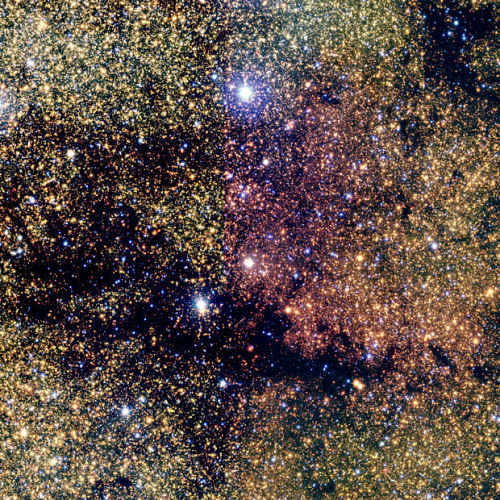
Milky Way Shows 84 Million Stars in 9 Billion Pixels
Side Note: The two images shown above are mere crop outs from ESA’s recent hit: The 9 Billion Pixel Image of 84 Million Stars. These two focus on the bright center of the image for the purpose of highlighting what a peak at 84,000,000 stars looks like.
Astronomers at the European Southern Observatory’s Paranal Observatory in Chile have released a breathtaking new photograph showing the central area of our Milky Way galaxy. The photograph shows a whopping 84 million stars in an image measuring 108500×81500, which contains nearly 9 billion pixels.
It’s actually a composite of thousands of individual photographs shot with the observatory’s VISTA survey telescope, the same camera that captured the amazing 55-hour exposure. Three different infrared filters were used to capture the different details present in the final image.
The VISTA’s camera is sensitive to infrared light, which allows its vision to pierce through much of the space dust that blocks the view of ordinary optical telescope/camera systems.
source
Extraterrestrial Life May Be Closer Than We Think
Just when we think we have the universe somewhat figured out, it throws us a massive curveball from our very own backyard. Hold on to your telescopes, everyone, because one of our own planetary neighbors right around the corner may have the right conditions for extraterrestrial life.
On April 14, a paper published in Science Mag pointed out biochemical signatures of hydrogen production in the hydrothermal reactions in the form of plumes that erupt from the ice surface of Enceladus, one of Saturn’s moons. Molecular hydrogen is one of the building blocks of life because it is the ideal food source for microbes and bacteria, which are at the forefront of every food and energy chain (at least on Earth). This implies that the ocean beneath the ice has enough chemical activity and organic matter to maintain the right conditions to sustain life, at least on the molecular level. This kind of chemistry can indicate habitable zones in Enceladus’ ocean.
To provide a bit of a context from here on Earth: our own oceans contain deep-sea hydrothermal vents that are home to complex and important ecosystems that allow microorganisms to live and grow by using energy from the minerals produced by these vents. These microorganisms are necessary for food and energy chains to form since larger organisms feed on these microorganisms and create entire ecological communities. Many scientists have pointed out these kinds of superheated environments as prime locations for life to begin.
But having the right conditions for life doesn’t mean already harboring life. There is still a lot that we don’t know about what’s going on below the surface of Enceladus. While scientists have known about its ocean since 2005, it is only now that technology has improved to the point where it can pick up sensitive biochemical signatures and provide a more detailed picture of Saturn’s icy moon.
Recently, NASA has announced a mission called Europa Clipper that will explore Europa, another one of Jupiter’s icy moons with an ocean. It will launch sometime in the 2020s. Perhaps NASA will consider stopping by Enceladus...who knows what we can find there?
Hey Dianne. I love love love this theme! It is sooo cool. I have no idea how you did it (was it witchcraft?!?!). I love that you have this calming music playing as well. everything is just awesome --Jennifer Holden
Hi Jennifer, thank you so much for visiting my blog! The theme took forever to edit and format, but I think it’s totally worth it :D
Origins is one of my favorite documentaries of all time. Neil deGrasse Tyson does a marvelous job of narrating a story interwoven with strong scientific evidence, great artistic visuals, and immersive story-telling. While Origins is an old documentary (first shown in 2004), many of its content is still applicable today.
One of my favorite aspects of Origins is its ability to explain to the viewer why understanding the start of our universe is important. Often times, the answer to “How did life start?” is filled with complex scientific concepts and theories. Origins breaks down these complicated explanations into points that anyone can digest. I highly recommend it to any space enthusiast out there.
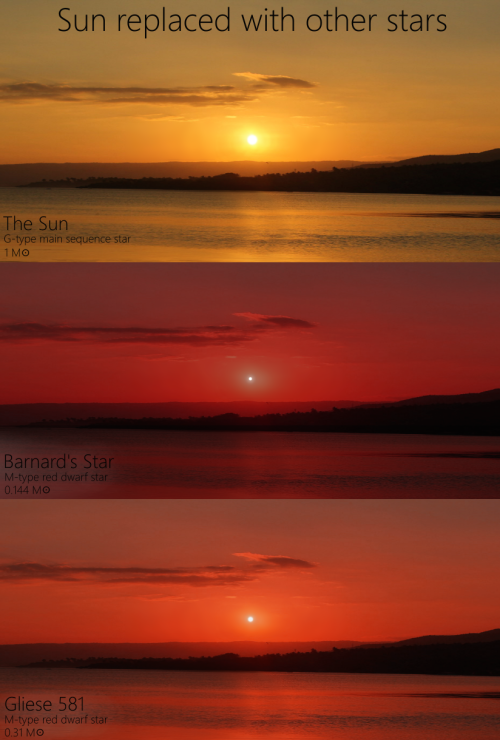
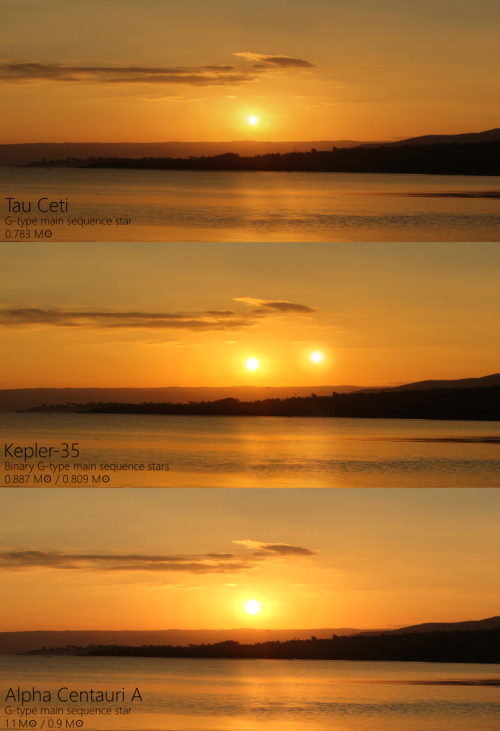
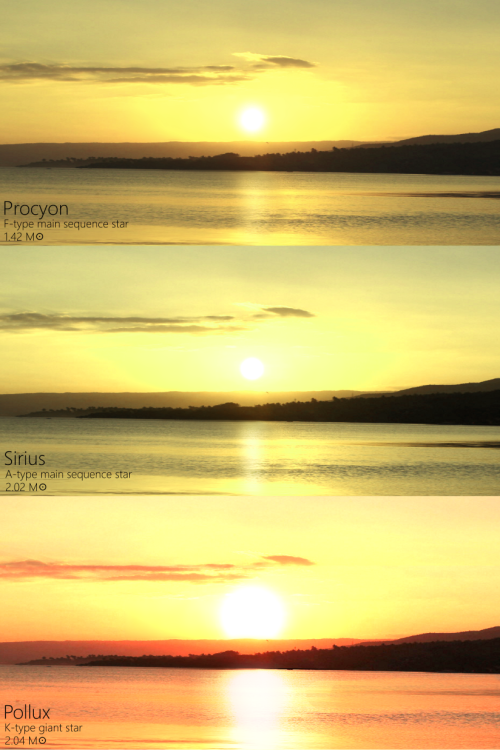
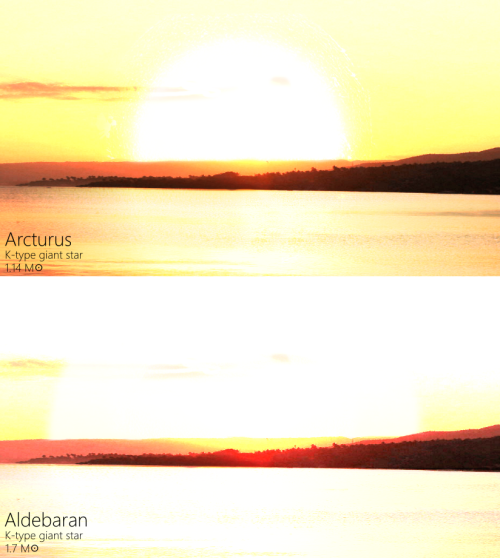
The Sun replaced with other Stars
This visualization shows how the sunset could look like to a human observer if our Sun was replaced by some of the other stars in our galaxy with different sizes and magnitudes, namely Barnard’s Star, Gliese 581, Tau Ceti, Kepler-23, Alpha Centauri A, Procyon, Sirius, Pollux, Arcturus and Aldebaran.
It is just a concept, as liquid water and the Earth as we know it could not exist in the vicinity of the most stars in this graphic. Visualizations are based on the absolute brightness, spectral class and the radius of each star.
by Martin Vargic
My Constellation
I was born with stars in my eyes.
I mean this in a very literal sense! I was born in an island village that didn’t have any electricity, on a clear moonless night when millions of bright stars unfurled across the dark sky. And (according to my baby pictures) my hospital cradle was right next to the window which afforded a wide view of the ocean waves and – yep, that’s right – the stars. One of my earliest memories is that of the stars, though I’m not sure if that is from when I was a baby, or when I was slightly older.
Nevertheless, the night sky and its bright inhabitants have been constants in my life for as long as I can remember. From as early as my toddling years, I would always make it a point to my parents to let me stay outside long enough to stargaze. I didn’t know why I was so fascinated with the night sky – it was just instinctive to look up and be in wonder. My love for the stars became so apparent that my grandparents, aunts, and uncles decided to save enough money to buy me a secondhand telescope, a gift that I cherished until I had to move to the United States and leave it behind to my younger relatives.
That telescope opened up a new world for me, one where I only had to look through a pair of simple lens to excitedly meet my nighttime friends face-to-face. While the telescope wasn’t very advanced, it was strong enough to show me the faint outlines of neighboring planets, the tail-ends of occasional comets, and the blurry but beautiful glows of twinkling stars. “There’s stuff out there! STUFF!” I remember saying to my family after my first time looking through the telescope, “there’s a bunch of stuff! So much stuff!”
From there, it was inevitably easy to fall in love with outer space and all of its complications and mysteries. My curiosity and questions about the “stuff” I saw grew in leaps and bounds, propelling me to – in essence – attack our local library to get my hands on anything related to space. I was overjoyed to see an entire shelf dedicated to space science and astronomy. But when I finished devouring the texts there a few weeks later, I was devastated. Surely there was more to read, more to learn more out there?
Can you imagine, then, how I reacted when I was told that my parents and I were moving to America? The America that had sent people to the moon, built incredible spacecrafts and satellites that were currently circling the globe in low orbit, and helped found the International Space Station? I was ecstatic, and my hopes for the future far outweighed my reservations about leaving the only home I had ever known.
If there were any reservations, though, they disappeared the moment I woke up at some point during the 22-hour flight, looked out my tiny plane window, and saw with wide eyes…
… the stars – right there – right in front of me – right within my reach. At eight years old, I genuinely thought the plane was flying in a sea of stars, and kept my face mushed against the glass until a plane attendant asked me to close the window (I did close the window, but I opened it again after she left.)
It’s funny, looking back at that starry-eyed eight-year-old. I want to tell her that there’s only so much more to look forward to. I want to tell her that when she’s ten, she’s going to visit a place called Kennedy Space Center and firmly declare to everyone in the tour group that she will become an astronaut one day. I want to tell her that when she’s thirteen, she’ll visit another place called the Orlando Science Center and peek through an enormous telescope that will show her the distant planet of Saturn in color, and she’ll be so shocked that she’ll ask if the picture was a sticker on the lens. I want to tell her that when she’s eighteen, she’ll gain two mentors who will encourage her to pursue her love for the stars, and help her get started on the path to getting there… I want to tell her that the next eleven years won’t be easy, and there will be times when she’ll feel as if the stars could never be more far away or unreachable.
But I think she’ll end up just fine. She was born with stars in her eyes, after all.
Hope for Life on Trappist-1 is a Little Too Bright for Comfort
Bad news, everyone: Trappist-1 may not be the extraterrestrial paradise we thought it would be. On March 29, 2017, a new study was released from the Konkoly Observatory in Hungary that analyzed photometric data on Trappist-1 which was collected by NASA’s K2 mission.
The study suggested that the host star of the Trappist-1 system produces too many powerful solar flares to allow its planets to host and sustain life. Data pointed out 42 high-energy flares that occurred over an 80-day period, 5 of which were “multi-peaked” which means they gave off multiple bursts of energy in one instance. The average time between these flares was 28 hours.
To provide a comparison to understand the magnitude of the solar flares -- the strongest flare on Trappist-1 is equivalent in release of energy to our own Carrington Event of 1859, which would destroy global communications if it happened today. During the Event, the flare sent powerful electrical surges through telegraph lines and produced tropical aurorae so bright, they woke up Rocky Mountain gold miners in the middle of the night because they thought it was morning.
Now, some people might say, “But Earth has managed to survive powerful solar flares in the past. Why can’t Trappist-1 do the same?”
Well, there may be a few reasons why Trappist-1 may no longer be the place to sustain life:
1) Our wonderful Earth has in place a magnetic field that protects us from the worst effects of our host star’s stellar magnetic outbursts, but it is not yet known whether or not the Trappist-1 planets have this same defensive capability.
2) Both the frequency and magnitude of Trappist-1′s solar flares may prohibit its planets from even recovering from previous flares. According to this study done a year ago, it would take 30,000 years for a planet’s atmosphere to recover from just one of a high-intensity flare. Solar flares are occurring every 28 hours on Trappist-1. Logic, then, points out that there is a very small chance of life being possible on any of Trappist-1′s planets.
3) Trappist-1′s planets are very, very close to their Sun -- much closer than we are to our own. This means that the near-constant flaring would likely destroy any chance of stability in the planets’ atmospheres, unless (on the small chance) they somehow have incredibly powerful magnetospheres.
This is definitely disappointing news. I think many people (myself included) had a lot of hope riding on Trappist-1 for the possibility of sustaining life and being a true sister solar system to our own.
But not all hope is lost! There’s still a lot that we can’t confirm about this mysterious and volatile solar system. Scientists are relying on the launch of the James Webb Space Telescope to probe Trappist-1 and give us a more detailed look on what’s going on in that side of the universe. The telescope will launch in 2018, so don’t give up on Trappist-1 just yet! A lot can happen in one year.
Really interesting to see a space-centric blog that isn't just pretty pictures of stars without any context. Your analyses and explanations of ongoing news aren't bad at all, so keep up the good work.
Thank you so much! I do my best to make sure my entries have good content, so I’m happy to know that you’re enjoying them!
CONSTELLATION: (noun) Group of stars that form a recognizable pattern to which a mythological or earth-based name is assigned Pattern of stars whose name or is associated with different stories and meanings Story told by stars connected across the infinite night sky, overlapping with countless other stories that have unfolded from ancient supernovas, whose imaginary lines urge our eyes up from the chaos of the world around us to the unknown vastness in which we are but a speck of dust -------- Hi! I’m a starry-eyed astrogeek named Dianne who loves absolutely everything that has to do with the stars and outer space. When I’m not studying or preparing to take over NASA one day, you can find me trying to stargaze despite city lights or happily planning my next road trip.
35 posts
